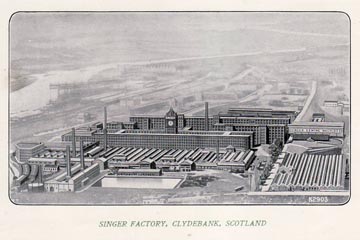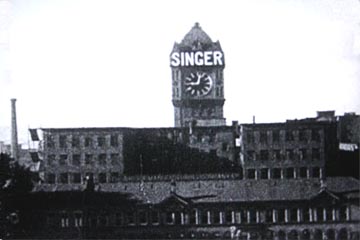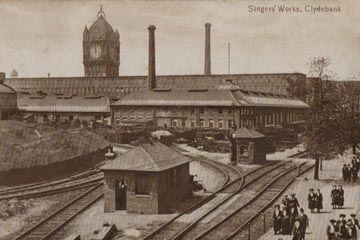Singer Factories - Kilbowie, Clydebank, Scotland
In 1867 the Singer Company decided that the demand for their sewing machines in the UK was sufficiently high to open a local factory. Glasgow was selected for its iron making industries, cheap labour and possibly because at the time the General Manager of the US Singer Sewing Machine Company was George McKenzie, who was of Scottish decent. The company obtained a lease on land at 1 Love Loan, High John Street near Queen Street Station and machinery and machine parts were shipped over from the US. Demand for sewing machines outstripped production at the new plant and by 1873 a new larger factory was completed near Bridgeton Cross. By now Singer employed over 2,000 people in Scotland but still they could not produce enough machines.
In 1882 George McKenzie, the soon to become President of the Singer Sewing Machine Company, undertook the ground breaking ceremony on 46 acres of farmland at Kilbowie, Clydebank and the largest Singer factory in the world started to be built. Originally two main building were constructed, each 800ft long and 50ft wide and 3 storeys high. These were connected by three wings. Built above the middle wing was a huge 200ft tall clock tower with the 'Singer' name clearly displayed for all to see from miles around. 2-3/4 miles of railway lines were laid through the factory to connect the different departments such as the boiler room, foundry and shipping and to lines between Glasgow, Dumbarton and Helensburgh stations. Robert McAlpine and Co. were the building contractor and the factory was designed to be fire proof with water sprinklers, making it the most modern factory in Europe at that time.

As different departments in the factory were completed, the workers moved from the old sites to the new one at Kilbowie and the factory was finished in 1885. With nearly a million square feet of space and almost 7,000 employees it was possible to produce on average 13,000 machines a week, making it the largest sewing machine factory in the world. The Clydebank factory was so productive that in 1905 the US Singer Company set up the Singer Manufacturing Company Ltd. as a UK registered company. Although Kilbowie, Clydebank was at that time the world's largest sewing machine factory, demand still continued to exceed production, so each building was extended upwards to 6 storeys high.

During 1911 twelve women cabinet polishers at the Kilbowie plant went on strike when their work was reorganised in a way that increased their workload but decreased their wages. Within two days almost all of the 11,000 workforce came out on strike in sympathy with the women. The expression of solidarity was most likely the influence of the Industrial Workers of Great Britain (IWGB) and the Socialist Labour Party which were both active within the plant. These two political groups both promoted the idea of industrial unionism and gave leadership to the striking workers. In response, the Singer management went on the offensive by closing the works and threatening to remove production to other plants in Europe. They also let it be known they would ensure that workers would find it very difficult to ever get other employment in the Glasgow area if the strike was not brought to an immediate end.
After the company's ultimatum a ballot of the workers voted to end the strike and the strike committee had no option but to concede defeat. The dispute ended with an unconditional return to work on 10 April 1911. Soon afterwards the company initiated a campaign of systematic victimisation which resulted in the sacking of over 400 workers, including all the strike leaders and members of the IWGB.

Another notable event in the plants history occured on the night of 13th and 14th March 1941, when German bombers attacked the shipyards and industrial factories of Clydeside. On the first night, during a nine hour bombardment, over 200 bomber aircraft dropped high explosive bombs, incendiary bombs and land mines. The intended primary targets were the John Brown and Co. ship yards and the munitions being produced in the Singer Sewing Machine Co factory, but it was the town itself that bore the brunt of the damage. The Singer factory with its famous clock tower was badly damaged when incendiary bombs landed on Singer's timber yard, resulting in a huge fire.
During the second world war Singer continued to produce sewing machines but in smaller numbers. These machines were needed for making army uniforms and for members of the public to 'make do and mend'. Surprisingly the machines continued to be made with nickel plated parts and their charateristic ornamental gold decals.
The Singer factory also produced munitions for the war effort and had its own Home Guard unit so that it could be protected if it came under attack from a German invasion. On the second night of bombing the town endured another 7-1/2 hours of heavy bombing. Over the 2 days 528 civilians were killed and over 617 seriously injured. Over 35,000 civilians lost their homes, many of them shipyard workers and Singer employees who lived in the Clydebank tenements near to the plants.
From its opening in 1884 until 1943 the Kilbowie factory produced approximately 36,000,000 sewing machines. Singer was the world leader and sold more machines than all the other makers added together. At the height of it's productiveness in the early 1960's, Singer employed over 16,000 workers but by the end of that decade compulsory redundancies were taking place and 10 years later the workforce was down to 5,000.
Between 1961 and 1964 the factory underwent a major modernisation programme costing £4 million, when it ceased production of cast iron machines and was converted to the production of machines with aluminium bodies. The famous Singer clock was demolished in 1963 during this work.
Financial problems and lack of orders forced the world's largest sewing machine factory to close in June 1980, bringing to an end over 100 years of sewing machine production in Scotland. The complex of buildings was demolished in 1998.
Those who are further interested in the production process and working conditions at the Kilbowie factory in its heyday may like to obtain a copy of the documentary film titled 'Birth Of A Sewing Machine'. This fascinating 74 minute long film was made at the factory in 1934. Copies may be obtained on DVD from The Scottish Screen Archives in Glasgow.
